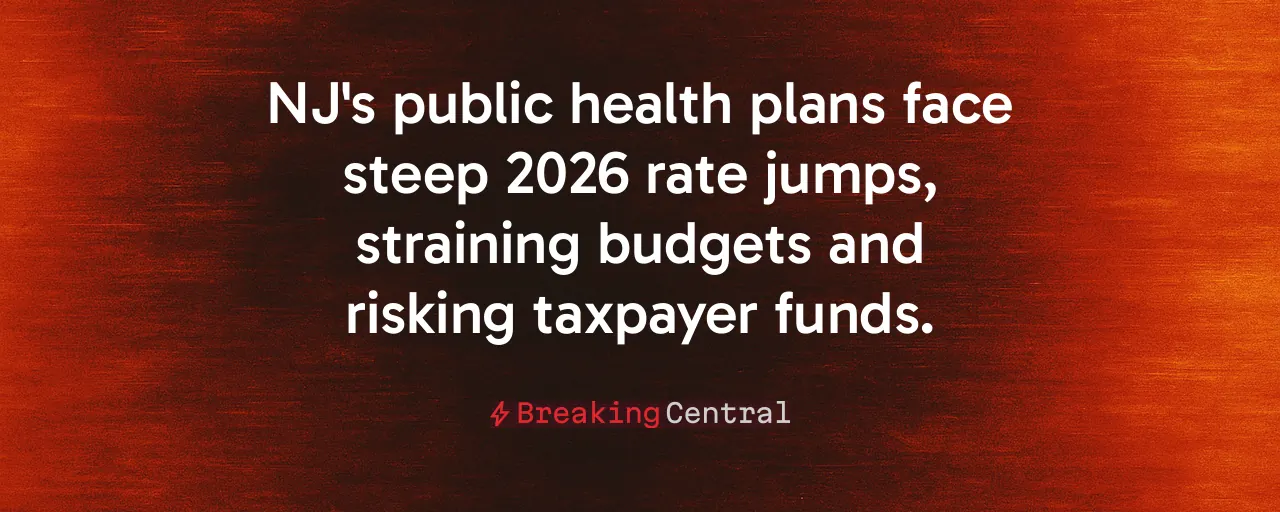A Fiscal Alarm Rings in Trenton
New Jersey's public employee health plans are sounding a fiscal alarm. Actuary AON recently recommended staggering premium increases for 2026: 36.5 percent for local government plans, 29.7 percent for school employees, and 21 percent for state workers. These hikes signal a deeper crisis, one that threatens taxpayers, public workers, and the state's financial stability. The plans, covering nearly 800,000 people, have seen costs spiral out of control, with local government premiums doubling over the past five years.
The numbers paint a grim picture. In 2024 and 2025 alone, the plans racked up over $450 million in losses. Prescription drug costs, especially for weight-loss medications like Wegovy, are skyrocketing, alongside medical inflation and overuse of high-cost care. Meanwhile, local employers are fleeing the plans, leaving a riskier, costlier pool behind. The problem is a growing burden on families and communities already stretched thin.
Taxpayers Foot the Bill
Every dollar spent on these plans comes from New Jersey's taxpayers. Local government plans, facing a $600 million cost increase, will lean harder on property taxes, which already rank among the nation's highest. Municipal budgets, already strained, face tough choices: raise taxes, cut services, or both. School districts, grappling with a 29.7 percent hike, may divert funds from classrooms to cover health costs, shortchanging students.
The state isn't immune either. Borrowing $150 million from state reserves to prop up local plans, as allowed in 2024, only delays the inevitable. Without action, taxpayers face a future of escalating costs and potential bailouts. Public workers, too, risk higher premiums or reduced benefits, squeezing household budgets. The system, as it stands, pits workers against taxpayers in a lose-lose scenario.
Why Costs Keep Climbing
The root of the problem lies in the plans' design. New Jersey's public health benefits are among the nation's most generous, with actuarial values topping 97 percent, far above the 90 percent benchmark for premium private plans. Low deductibles and minimal cost-sharing encourage overuse, driving up claims. Studies from Rutgers and RAND confirm that such rich plans inflate per-member costs by up to 10 percent.
Prescription drugs are another culprit. GLP-1 drugs like Ozempic, used for weight loss and diabetes, now top spending across all plans, with annual costs per user exceeding $10,000. Medical inflation, at 8 percent, and a shift to pricier care settings add fuel to the fire. Adverse selection, where low-risk employers exit, leaves plans with sicker, costlier members, pushing premiums higher still.
Lessons From the Past
New Jersey's health plan woes aren't new. Since the 1970s, the state has expanded coverage to local employers, chasing economies of scale. But generous benefits, locked in by collective bargaining, resisted reform. A 2011 law increased employee contributions, yet left plan designs largely untouched. By 2022, a 22 percent premium spike sparked bipartisan concern, yet structural fixes remained elusive.
The 2020 creation of a lower-cost educators' plan briefly slowed school plan growth, but its impact faded as drug costs surged. Last year, borrowing authority shored up local reserves, but the Treasury's 2025 warning of a 'death spiral' underscores the need for deeper change. History shows that patching the system provides temporary relief, not lasting solutions.
A Path to Stability
Bold, practical steps are needed to fix this crisis. Redesign plans to align with private-sector norms. Higher deductibles and coinsurance caps can curb overuse without slashing core coverage. Tiered networks, which steer patients to high-value providers, have cut spending by up to 15 percent where adopted, yet only a fraction of workers enroll. Expanding these options, with clear incentives, could save millions.
Tackle drug costs head-on. Reference-based pricing, tying payments to cost-effective benchmarks, has worked in other states. Bulk purchasing or subscription models for high-cost drugs like Wegovy could cap liability. Phasing out the local government plan, encouraging private-market competition, would reduce taxpayer exposure while preserving worker choice.
Protecting Workers and Taxpayers
Reforms need to balance worker needs with fiscal reality. Public employees deserve quality care, but benefits far outpacing private-sector standards strain public trust. Increasing employee premium shares, as seen in other states, can share costs equitably. Strong reserve ratios, enforced by law, would prevent future borrowing, ensuring solvency without taxpayer bailouts.
Municipalities and school districts need flexibility to manage costs. Allowing more employers to opt into high-value plans or private coverage could stabilize the risk pool. These steps protect workers from sudden benefit cuts while shielding taxpayers from runaway taxes.
A Call to Act
New Jersey stands at a crossroads. The 2026 premium hikes serve as a warning, not an unchangeable destiny. By embracing smarter plan designs, drug cost controls, and market-driven options, the state can stabilize its health plans without sacrificing quality. Delay only invites steeper costs and tougher choices.
Taxpayers, workers, and local governments all have a stake in this fight. A system that pits them against each other serves no one. Thoughtful reform, grounded in fiscal discipline and fairness, can rebuild trust and secure coverage for years to come.
The Health Benefits Commissions should act decisively when finalizing these rates. The real work lies in rethinking a system that, left unchecked, threatens New Jersey's future. Half-measures are no longer sufficient; bold action starts now.
